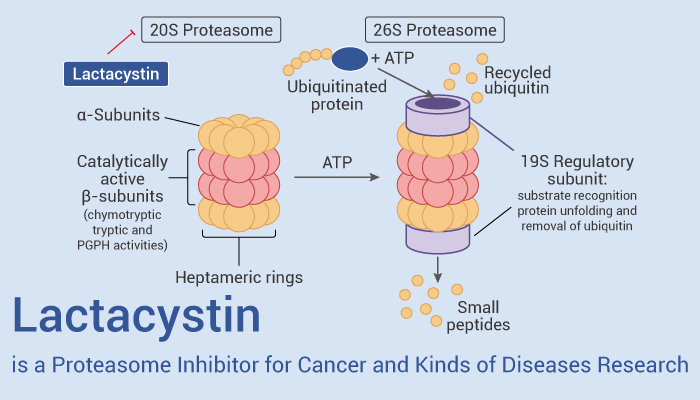Proteasomes are very large protein complexes inside all eukaryotes and archaea, and in some bacteria. In eukaryotes, they are located in the nucleus and the cytoplasm. The main function of the proteasome is to degrade unneeded or damaged proteins by proteolysis. Enzymes that carry out such reactions are called proteases. Proteasomes are part of a major mechanism by which cells regulate the concentration of particular proteins and degrade misfolded proteins. Proteins are tagged for degradation with a small protein called ubiquitin. The tagging reaction is catalyzed by enzymes called ubiquitin ligases. Once a protein is tagged with a single ubiquitin molecule, this is a signal to other ligases to attach additional ubiquitin molecules. The result is a polyubiquitin chain that is bound by the proteasome, allowing it to degrade the tagged protein.

Lactacystin is a Proteasome Inhibitor for Cancer and Kinds of Diseases Research
Lactacystin is a potent, orally active, irreversible, cell-permeable, selective 20S proteasome inhibitor (IC50 = 4.8 μM). And it also inhibits the lysosomal enzyme cathepsin A. Lactacystin inhibits cell growth and induces apoptosis and cell cycle arrest, and has antiviral and antioxidative activity. Lactacystin induces neurite outgrowth and hypertension. Therefore, Lactacystin has the potential for the research of cancer, Neurological Disease, hypertension and Malaria, and so on.
In vitro, Lactacystin (up to 25.6 µM, 1 h) has no cytotoxicity to HeLa or SH-SY5Y cells. And it decreases RVP infection by 63.8% in HeLa and by 74.5% in SH-SY5Y cells. What’s more, Lactacystin (2.5 μM) in combination with Parthenolide (5 μM) causes a synergistic increase in the apoptotic fraction of the drug-resistant L1210 cells. Also, Lactacystin(2.5, 5 and 10 µM, 24 h)inhibits the proliferation (IC50 value of 10 μ M) and increases the apoptotic in C6 cells. And Lactacystin (10μM, 24 h) increases Cisplatin-induced ER stress-associated apoptosis in Hela cells. In addition, Lactacystin (7.5 μM, 4-48 h) increased reactive oxygen species and GSH levels in HT-29 cells. Lactacystin (1, 2.5, 5 μM, 24 h) induces stellation in astrocytes from neonatal rat cortex. Moreover, Lactacystin (10μM, 8-24 h) induces apoptosis, G2/M cell cycle arrest in the PC12 cells.
In vivo, Lactacystin (2 μg for ICV) induces a Parkinson’s disease-like motor phenotype 5-7 days after injection in young and adult mice. Lactacystin (1.0 ug or 5.0 µg/20g for 7days) results in significantly smaller tumor and promotes apoptosis than control in C6 orthotopic xenograft tumor models. And Lactacystin (5 mg/kg/day, dissolved in drinking water, six weeks) induces model of hypertension in male adult Wistar rats.
In conclusion, Lactacystin is a Proteasome Inhibitor for Cancer and Kinds of Diseases Research.
Reference:
[1] Vet Pathol. 2010 Mar;47(2):358-67.
[2] Anticancer Res 2002 Nov-Dec;22(6C):3805-9.